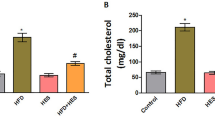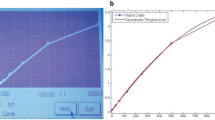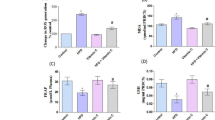Abstract
Hyperlipidemia is one of the leading causes of, atherosclerosis, and cardiovascular disease. In this study, we evaluated the protective role of hesperidin (HES) against lipidemic stress in a hyperlipidemic model of rats. We developed a hyperlipidemic model of the rat through an i.p dose of poloxamer-407, 0.5 g/kg body weight for 3 alternative days in a week for 30 days and rats were supplemented with HES orally (100 mg/kg body weight) once daily. Bodyweight, fasting glucose, insulin, HOMA-IR index, triglyceride, cholesterol, ROS, FRAP, GSH, PMRS, AGE, MDA, PCO, AOPP, PON-1, TNF-α and IL-6, SGPT and SGOT were estimated in blood and plasma, and histopathology was done in liver tissue. Our data show that oxidative stress, inflammatory markers were increased in the P-407 treated group. Liver tissue histology also changes in the hyperlipidemic groups of rats.HES supplementation protects against P-407 induced alterations and maintains the redox homeostasis. Our results provide evidence that HES protects against lipidemic stress and redox imbalance induced by P-407 in rats.





Similar content being viewed by others
Data availability statement
The information that helps the finding of this study is accessible from the corresponding author upon reasonable request.
References
Abuelsaad ASA, Allam G, Al-Solumani AAA (2014) Hesperidin Inhibits Inflammatory Response Induced by Aeromonas hydrophila Infection and Alters CD4 +/CD8 + T Cell Ratio. Mediators Inflamm 2014:1–11
Ahmad S, Beg ZH (2014) Mitigating the role of thymoquinone rich fractions from Nigella sativa oil and its constituents, thymoquinone and limonene on lipidemic-oxidative injury in rats. SpringerPlus 3(1):316
Aslan R, Sekeroğlu MR, Tarakçioğlu M, Köylü H (1997) Investigation of malondialdehyde formation and antioxidant enzyme activity in stored blood. Haematologia (Budapest) 28(4):233–237
Assini JM, Mulvihill EE, Huff MW (2013) Citrus flavonoids and lipid metabolism. Curr Opin Lipidol 24(1):34–40
Ayub A, Mackness MI, Arrol S, Mackness B, Patel J, Durrington PN (1999) Serum paraoxonase after myocardial infarction. Arterioscler Thromb Vasc Biol 19(2):330–335
Belskaya LV, Kosenok VK, Massard Z, Zav’yalov AA (2016) Status indicators of lipid peroxidation and endogenous intoxication in lung cancer patients. Annals Russ Med Sci 71(4):313–322
Benzie IFF, Strain JJ (1996) The ferric reducing ability of plasma (FRAP) as a measure of “antioxidant power”: the FRAP assay. Anal Biochem 239(1):70–76
Beutler E, Gelbart T, Pegelow C (1986) Erythrocyte glutathione synthetase deficiency leads not only to glutathione but also to glutathione-S-transferase deficiency. J Clin Invest 77(1):38–41
Blonder JM, Baird L, Fulfs JC, Rosenthal GJ (1999) Dose-dependent hyperlipidemia in rabbits following administration of poloxamer 407gel. Life Sci 65(21):261–266
Bok S-H, Lee S-H, Park Y-B, Bae K-H, Son K-H, Jeong T-S, Choi M-S (1999) Plasma and Hepatic Cholesterol and Hepatic Activities of 3-Hydroxy-3-methyl-glutaryl-CoA Reductase and Acyl CoA: cholesterol transferase are lower in rats fed citrus peel extract or a mixture of citrus bioflavonoids. J Nutr Biochem 129(6):1182–1185
Carquin M, D’Auria L, Pollet H, Bongarzone ER, Tyteca D (2016) Recent progress on lipid lateral heterogeneity in plasma membranes: from rafts to submicrometric domains. Prog Lipid Res 62:1–24
Chen M, Ye Y, Ji G, Liu J (2010) Hesperidin upregulates heme oxygenase-1 to attenuate hydrogen peroxide-induced cell damage in hepatic L02 cells. J Agric Food Chem 58(6):3330–3335
Chen J-H, Lin X, Bu C, Zhang X (2018) Role of advanced glycation end products in mobility and considerations in possible dietary and nutritional intervention strategies. Nutr Metab (Lond) 15(1):72
Cheng Y-C, Sheen J-M, Hu WL, Hung Y-C (2017) Polyphenols and oxidative stress in atherosclerosis-related ischemic heart disease and stroke. Oxid Med Cell Longev 2017:1–16
Desmarchelier C, Borel P, Lairon D, Maraninchi M, Valéro R (2019) Effect of nutrient and micronutrient intake on chylomicron production and postprandial lipemia. Nutrients 11(6):1299
Dianzani MU (1989) Lipid peroxidation and cancer: a critical reconsideration. Tumori 75(4):351–357
Elavarasan J, Velusamy P, Ganesan T, Ramakrishnan SK, Rajasekaran D, Periandavan K (2012) Hesperidin-mediated expression of Nrf2 and upregulation of antioxidant status in senescent rat heart: hesperidin and cardiac aging. J Pharm Pharmacol 64(10):1472–1482
Eruslanov E, Kusmartsev S (2010) Identification of ROS Using Oxidized DCFDA and Flow-Cytometry. In: Advanced protocols in oxidative stress II (Armstrong D, Ed.). Humana Press, pp 57–72
Esterbauer H, Cheeseman KH (1990) Determination of aldehydic lipid peroxidation products: malonaldehyde and 4-hydroxynonenal. Methods Enzymol 186:407–421
Fatima M, Kesharwani RK, Misra K, Rizvi SI (2013) Protective effect of theaflavin on erythrocytes subjected to in vitro oxidative stress. Biochem Res Int, pp 1–7
Feingold KR, Grunfeld C (1992) Role of cytokines in inducing hyperlipidemia. Diabetes 41(2):97–101
Fuster JJ, Ouchi N, Gokce N, Walsh K (2016) Obesity-induced changes in adipose tissue microenvironment and their impact on cardiovascular disease. Circ Res 118(11):1786–1807
Garg A, Garg S, Zaneveld LJD, Singla AK (2001) Chemistry and pharmacology of the citrus bioflavonoid hesperidin. Phytother Res 15(8):655–669
Johnston TP (2004) The P-407-induced murine model of dose-controlled hyperlipidemia and atherosclerosis: a review of findings to date. J Cardiovasc Pharmacol 43(4):595–606
Johnston TP, Palmer WK (1993) Mechanism of poloxamer 407-induced hypertriglyceridemia in the rat. Biochem Pharmacol 46(6):1037–1042
Johnston TP, Korolenko TA, Sahebkar A (2017) P-407-induced mouse model of dose-controlled hyperlipidemia and atherosclerosis: 25 years later. J Cardiovasc Pharmacol 70(5):339–352
Kalousová M, Zima T, Tesař V, Dusilová-Sulková S, Škrha J (2005) Advanced glycoxidation end products in chronic diseases—clinical chemistry and genetic background. Mutat Res 1(2):37–46
Kattoor AJ, Pothineni NVK, Palagiri D, Mehta JL (2017) Oxidative stress in atherosclerosis. Curr Atheroscler Rep 19(11):42
Kumar R, Akhtar F, Rizvi SI (2020) Hesperidin attenuates altered redox homeostasis in an experimental hyperlipidemic model of rat. Clin Exp Pharmacol Physiol 47(4):571–582
Le Lay S, Simard G, Martinez MC, Andriantsitohaina R (2014) Oxidative stress and metabolic pathologies: from an adipocentric point of view. Oxid Med Cell Longev 2014:1–18
Liguori I, Russo G, Curcio F, Bulli G, Aran L, Della-Morte D, Gargiulo G, Testa G, Cacciatore F, Bonaduce D, Abete P (2018) Oxidative stress, aging, and diseases. Clin Interv Aging 13:757–772
Lowry OH, Rosebrough NJ, Farr AL, Randall RJ (1951) Protein measurement with the Folin phenol reagent. J Biol Chem 193(1):265–275
Mahmoud AM, Mohammed HM, Khadrawy SM, Galaly SR (2017) Hesperidin protects against chemically induced hepatocarcinogenesis via modulation of Nrf2/ARE/HO-1, PPARγ and TGF-β1/Smad3 signaling, and amelioration of oxidative stress and inflammation. Chem Biol Interact 277:146–158
Mahmoud AM, Hernández Bautista RJ, Sandhu MA, Hussein OE (2019) Beneficial effects of citrus flavonoids on cardiovascular and metabolic health. Oxid Med Cell Longev 2019:1–19
Mehdi MM, Rizvi SI (2012) Human plasma paraoxonase 1 (PON1) arylesterase activity during aging: correlation with susceptibility of LDL oxidation. Arch Med Res 43(6):438–443
Mobarak M, Hossain SA (2013) Lipid triad: an important predictor of dyslipidemia related disorders and its therapeutic intervention. J Glycomics Lipidomics 3(1):1. https://doi.org/10.4172/2153-0637.1000e114
Mulvihill EE, Burke AC, Huff MW (2016) Citrus flavonoids as regulators of lipoprotein metabolism and atherosclerosis. Annu Rev Nutr 36(1):275–299
Omari-Siaw E, Zhu Y, Wang H, Peng W, Firempong CK, Wang YW, Cao X, Deng W, Yu J, Xu X (2016) Hypolipidemic potential of perillaldehyde-loaded self-nanoemulsifying delivery system in high-fat diet induced hyperlipidemic mice: formulation, in vitro and in vivo evaluation. Eur J Pharm 85:112–122
Pandey KB, Rizvi SI (2009) Plant polyphenols as dietary antioxidants in human health and disease. Oxid Med Cell Longev 2(5):270–278
Ramana KV, Srivastava S, Singhal SS (2014) Lipid peroxidation products in human health and disease 2014. Oxid Med Cell Longev 2014:162414
Rizvi SI, Jha R, Maurya PK (2006) Erythrocyte plasma membrane redox system in human aging. Rejuvenation Res 9(4):470–474
Roohbakhsh A, Parhiz H, Soltani F, Rezaee R, Iranshahi M (2014) Neuropharmacological properties and pharmacokinetics of the citrus flavonoids hesperidin and hesperetin—A mini-review. Life Sci 113(1–2):1–6
Shelton P, Jaiswal AK (2013) The transcription factor NF-E2-related Factor 2 (Nrf2): a protooncogene? FASEB J 27(2):414–423
Stadtman ER, Levine RL (2000) Protein oxidation. Ann N Y Acad Sci 899:191–208
Upadhyay S, Dixit M (2015) Role of polyphenols and other phytochemicals on molecular signaling. Oxid Med Cell Longev 2015:504253
Wang X, Hasegawa J, Kitamura Y, Wang Z, Matsuda A, Shinoda W, Miura N, Kimura K (2011) Effects of hesperidin on the progression of hypercholesterolemia and fatty liver induced by high-cholesterol diet in rats. J Pharmacol Sci 117(3):129–138
Witko-Sarsat V, Friedlander M, Capeillère-Blandin C, Nguyen-Khoa T, Nguyen AT, Zingraff J, Jungers P, Descamps-Latscha B (1996) Advanced oxidation protein products as a novel marker of oxidative stress in uremia. Kidney Int 49(5):1304–1313
Wout ZG, Pec EA, Maggiore JA, Williams RH, Palicharla P, Johnston TP (1992) Poloxamer 407-mediated changes in plasma cholesterol and triglycerides following intraperitoneal injection to rats. J Parenter Sci Technol 46(6):192–200
Xiong H, Wang J, Ran Q, Lou G, Peng C, Gan Q, Hu J, Sun J, Yao R, Huang Q (2019) Hesperidin: a therapeutic agent for obesity. Drug Des Devel Ther 13:3855–3866
Yan Z, Zhong Y, Duan Y, Chen Q, Li F (2020) Antioxidant mechanism of tea polyphenols and its impact on health benefits. Anim Nutr 6(2):115–123
Zorov DB, Juhaszova M, Sollott SJ (2014) Mitochondrial reactive oxygen species (ROS) and ROS-induced ROS release. Phys Rev 94(3):909–950
Funding
This work was supported by a research grant to SIR from SERB-DST, Govt of India (EMR/2016/006470). The Department of Biochemistry is supported by the FIST grant of DST, New Delhi, India.
Author information
Authors and Affiliations
Contributions
RK Performing experiments, compiling results, a draft of the manuscript. FA Performing experiments. SIR Conception of the study, analysis of results, and manuscript preparation.
Corresponding author
Ethics declarations
Conflict of interest
The authors of this manuscript have no conflict of interest.
Rights and permissions
About this article
Cite this article
Kumar, R., Akhtar, F. & Rizvi, S.I. Protective effect of hesperidin in Poloxamer-407 induced hyperlipidemic experimental rats. BIOLOGIA FUTURA 72, 201–210 (2021). https://doi.org/10.1007/s42977-020-00053-1
Received:
Accepted:
Published:
Issue Date:
DOI: https://doi.org/10.1007/s42977-020-00053-1




